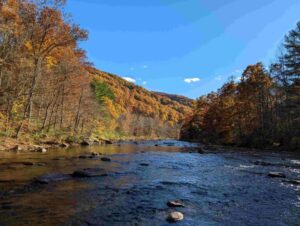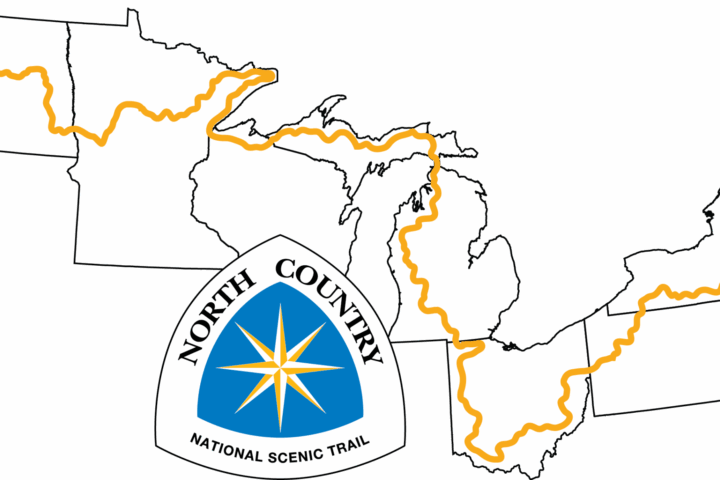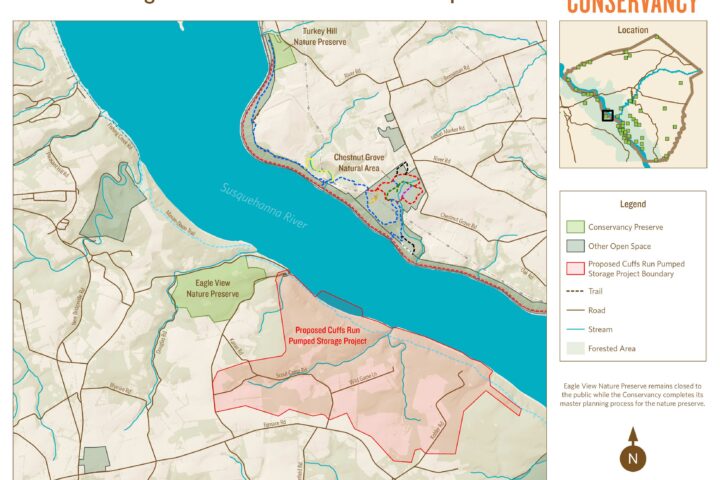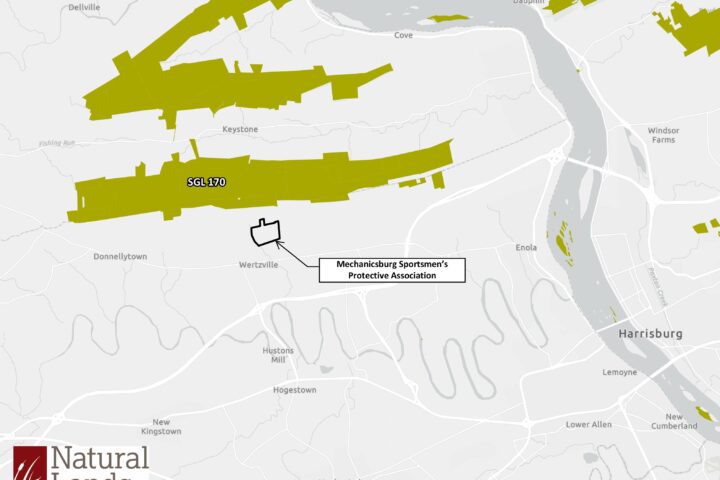Press release shared by Western Pennsylvania Conservancy August 28, 2024. Photo courtesy of the Conservancy.
The Western Pennsylvania Conservancy announced today the permanent protection of a 1,495-acre forested property for hunting, fishing, hiking and other recreational opportunities in Benezette Township, Elk County. The property was immediately transferred to the Pennsylvania Department of Conservation and Natural Resources to become open to the public as a new addition to Moshannon State Forest, bolstering the region’s climate resilience.
 This property, part of the Bennetts Valley area in the heart of Pennsylvania’s vast elk range in the Pennsylvania Wilds, includes a mix of hilltops, forested steep slopes and a significant riparian area along the Bennett Branch Sinnemahoning Creek. Johnson Run, classified by the Pennsylvania Fish and Boat Commission as a Class A Wild Trout stream, flows through the property. The property is also within one of the state’s largest blocks of unfragmented forest; large connected forests store large amounts of carbon and help combat the effects of climate change.
This property, part of the Bennetts Valley area in the heart of Pennsylvania’s vast elk range in the Pennsylvania Wilds, includes a mix of hilltops, forested steep slopes and a significant riparian area along the Bennett Branch Sinnemahoning Creek. Johnson Run, classified by the Pennsylvania Fish and Boat Commission as a Class A Wild Trout stream, flows through the property. The property is also within one of the state’s largest blocks of unfragmented forest; large connected forests store large amounts of carbon and help combat the effects of climate change.
The Conservancy has been protecting and restoring land in the Bennett Branch corridor since 2008, with more than 8,300 acres protected in Bennetts Valley. Bennetts Valley is an anchor area of the PA Wilds Conservation landscape, and is in the heart of Pennsylvania’s elk range and home of the Elk Country Visitor Center.
Many of these acquisitions have been conveyed to the state as additions to forests or game lands, however, the Conservancy continues to own the 1,465-acre Bennett Branch Forest for forest management, restoration and recreation, and the 24-acre Dr. Colson E. Blakeslee Memorial Recreation Area in Elk County, which hosts a mature floodplain forest and provides public access to the creek for fishing. Plus the Conservancy’s watershed conservation program has done large-scale abandoned mine drainage work on Cherry Run, a tributary to Bennett Branch.
“This is a wonderful and key addition to Bennetts Valley, a landscape that has been a priority for the Conservancy for more than a decade, and such a beautiful destination area within the PA Wilds,” says Tom Saunders, president and CEO of the Conservancy. “This further continues our mission to protect land in Bennett Branch Valley to support recreation, improve water quality or water sources, and safeguard habitat for elk and other native wildlife.”
Through the Appalachian Landscapes Protection Fund, the Open Space Institute provides capital grants to conservation projects within the globally important Appalachian region that address both the biodiversity crisis and climate change. “OSI is proud to have contributed to protecting this vital property,” says Bill Rawlyk, OSI’s Mid-Atlantic senior program manager.
“Beyond this land’s many attributes for recreation and biodiversity, conservation of the property will mitigate the impacts of climate change. Its complex landscapes and microclimates support diverse habitats that allow the movement of plant and animal species in response to a changing climate. Managed as part of Moshannon State Forest’s large, intact natural landscape, the forest will store carbon into the future, offsetting and moderating carbon emissions from human activities,” Rawlyk adds.
Since 1983, the Conservancy has acquired and transferred more than 5,000 acres to DCNR for Moshannon State Forest.
Conservation of this forestland was made possible thanks to grants from DCNR Bureau of Forestry and through OSI’s Appalachian Landscapes Protection Fund, which supports the protection of climate-resilient lands for wildlife and communities. This fund is made possible with a lead grant from the Doris Duke Foundation and with significant support from the Lyndhurst Foundation, Richard King Mellon Foundation, William Penn Foundation, Riverview Foundation, Tucker Foundation, Lookout Foundation, Footprint Foundation, as well as other foundations and individuals who understand the critical role that land protection plays in addressing the threats of climate change.
The Western Pennsylvania Conservancy (WPC) enhances the region by protecting and restoring exceptional places. A private nonprofit conservation organization founded in 1932, WPC has helped establish 11 state parks, conserved more than 285,000 acres of natural lands, protected or restored more than 3,000 miles of rivers and streams, and assessed thousands of wildlife species and their habitats. The Conservancy owns and operates Frank Lloyd Wright’s Fallingwater, which is on the UNESCO World Heritage List and symbolizes people living in harmony with nature. In addition, WPC enriches our region’s cities and towns through 130 community gardens and other green spaces and thousands of trees that are planted with the help of more than 7,000 volunteers. The work of the Conservancy is accomplished through the support of more than 10,000 members. For more information, visit WaterLandLife.org or Fallingwater.org.
About the Open Space Institute
The Open Space Institute (OSI) is a national leader in land conservation and efforts to make parks and other protected land more welcoming for all. Since 1974, OSI has partnered in the protection of more than 2.5 million at-risk and environmentally sensitive acres in the eastern U.S. and Canada. OSI’s land protection promotes clean air and water, improves access to recreation, provides wildlife habitat, strengthens communities, and combats climate change, while curbing its devastating effects.
Media Contact: Carmen Bray, Senior Director of Communications (cbray@paconserve.org)




